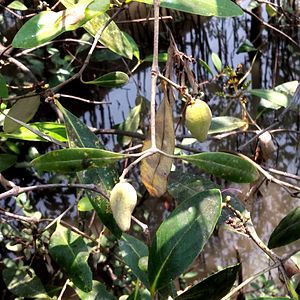Avicennia alba facts for kids
Quick facts for kids Avicennia alba |
|
|---|---|
 |
|
| Conservation status | |
| Scientific classification | |
| Genus: |
Avicennia
|
| Species: |
alba
|
The Avicennia alba is a type of mangrove tree. It grows in tropical areas around the world. You can find it along coasts and in river mouths. These special trees live in places like India, Southeast Asia, Australia, and Oceania.
Contents
What it Looks Like
Avicennia alba usually forms a low, thick, bushy top. Its branches often start close to the ground. This shrub usually doesn't grow taller than about 20 meters (66 feet).
Its roots are shallow. They send up many pencil-shaped roots called pneumatophores. These special roots stick out of the mud. They help the tree breathe and also help it get rid of extra salt.
The trunk has smooth, greenish-black bark. It has tiny cracks but doesn't peel off. The leaves are dark green on top. They are about 15 cm (6 inches) long and 5 cm (2 inches) wide. The underside of the leaves is silvery-grey. They grow in pairs, one across from the other.
The flowers are small and orange-yellow. They grow in clusters and have four petals. Each flower is about 4 mm (0.16 inches) wide when open. The fruits are greyish-green and shaped like a cone. They have a long, pointed tip up to 4 cm (1.6 inches) long. Each fruit holds just one seed.
In the Malay language, this mangrove is called api api putih. "Api" means "fire." This is because fireflies are attracted to this mangrove. "Putih" means "white," which refers to the pale underside of the leaves.
Where it Lives
You can find Avicennia alba in South and Southeast Asia. It also grows on islands in the South Pacific Ocean and in Australia. It is very common in the Sungei Buloh Wetland Reserve in Singapore.
This mangrove grows in areas affected by tides. It likes riverbanks and muddy parts of the seashore. It is a "pioneering species." This means it is one of the first plants to grow in new muddy areas. Its wide root system, with many pneumatophores, helps hold new mud and sand in place.
How it Grows
It's hard for young mangrove plants to grow in muddy places with strong tides. Because of this, Avicennia alba has a special way of growing. Its seeds start to develop and break through their outer coat. This happens even before the fruit opens to release the seeds.
Sometimes, the young shoot even breaks through the fruit while it's still on the tree. This is called vivipary. The young plants have tiny hooked hairs. You often see them growing in tangled groups.
Animals and Plants Around It
Many small animals without backbones, called invertebrates, live near Avicennia alba. The young forms (larvae) of some small moths eat the flower buds. Other moth larvae eat the fruits. Beetles also like to eat the leaves.
Mangrove swamps are home to many types of marine fungi. Avicennia alba is one of the trees where these fungi grow.
Its Status
Mangrove habitats are in danger from human activities. These include building on the coast and creating farms or fish ponds. Rising sea levels from global warming also threaten mangrove communities.
Avicennia alba faces these dangers too. However, it is listed as "least concern" by the IUCN Red List. This means it is not currently at high risk. It grows fast and recovers easily if it's cut. It is also found in many places and is common in most of its range.
What it's Used For
Avicennia alba grows quickly. It is sometimes planted with other mangroves like Sonneratia and Rhizophora. This helps to stop coastal erosion, which is when the land along the coast wears away.
The wood from Avicennia alba is not good for burning or making charcoal. But it is used to smoke rubber and fish. An extract from the inner wood is used in herbal medicine. It can be made into a tonic. The seeds can be boiled and eaten as a vegetable. Sometimes, you can find them in local markets.


